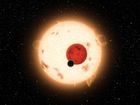 Life Sciences
Life Sciences
Among Darwin Advocates, Premature Celebration over Abundance of Habitable Planets
Ian Musgrave at Panda’s Thumb is all excited. He discovered a stray comment by Bill Dembski from 18 years ago, delivered at a conference at Seattle Pacific University, where in retrospect it sounds like Dembski was mistaken on what would turn out later to be the number of observable planets in the galaxy. From this, Musgrave derives the sweeping, celebratory headline, “The Discovery Institute Fails at Exoplanets.” Yay!
But wait. The occasion for all this merrymaking and victory-dancing is NASA’s announcement  of a newly discovered planet, Kepler 16-b, that goes around two suns, like Luke Skywalker’s home planet of Tatooine, some 200 lightyears from Earth.That’s very nice. However, Dembski’s point in his comment was that Darwinists like Richard Dawkins assume that habitable planets must be very common if life was going to kick-start itself on at least one of them, namely ours. And nothing indicates the new planet is in fact habitable much less habited. On the contrary, NASA says just the opposite.
of a newly discovered planet, Kepler 16-b, that goes around two suns, like Luke Skywalker’s home planet of Tatooine, some 200 lightyears from Earth.That’s very nice. However, Dembski’s point in his comment was that Darwinists like Richard Dawkins assume that habitable planets must be very common if life was going to kick-start itself on at least one of them, namely ours. And nothing indicates the new planet is in fact habitable much less habited. On the contrary, NASA says just the opposite.
Kepler-16b is “cold, gaseous and not thought to harbor life.” More:
This discovery confirms that Kepler-16b is an inhospitable, cold world about the size of Saturn and thought to be made up of about half rock and half gas. The parent stars are smaller than our sun. One is 69 percent the mass of the sun and the other only 20 percent. Kepler-16b orbits around both stars every 229 days, similar to Venus’ 225-day orbit, but lies outside the system’s habitable zone, where liquid water could exist on the surface, because the stars are cooler than our sun.
Undeterred, Ian Musgrave exults: “Based on the Kepler data of 2010, we can say that around 50% of Sun-like stars have planets, and there may be at least one million Earth-like planets in habitable zones in the Milky-Way alone. And that is probably an underestimate.”
We suspected Musgrave was celebrating prematurely, so we consulted Guillermo Gonzalez, a world-class expert on planet-habitability. Replying by email, Dr. Gonzalez confirmed our suspicion:
While the number of discovered exoplanets has risen dramatically since 1995, so has theoretical research on planet formation, evolution and habitability. What astronomers have found has surprised them. The typical exoplanetary system is very different from our Solar System. Jovian planets are being discovered in very tight or highly eccentric orbits. Jovian planets in our Solar System are characterized by large nearly circular orbits. Our Solar System looks ever more like the exception, and it is exceptional in ways that are life friendly.
While these exoplanets are being discovered, astronomers are discovering additional constraints on the habitability of planetary systems. Current theory goes far beyond the old view of the circumstellar habitable zone as being the only important criterion for determining the probability of habitability. Today, such processes as planet formation details, tidal forces, plate tectonics, magnetic field evolution, and planet-planet, planet-comet, and planet-asteroid gravitational interactions are found to be relevant to habitability (read the details in my contribution to the Nature of Nature proceedings).
What’s more, not only are more requirements for habitability being discovered, but they are often found to be interdependent, forming a complex “web.” This means that if a planetary system is found not to satisfy one of the habitability requirements, it may not be possible to compensate for this deficit by adjusting a different parameter in the system.
Sadly, you can’t put a cork back in a bottle of champagne. The habitability of planets is, it turns out, a far more complicated matter than Panda’s Thumb allows its readers to know.
